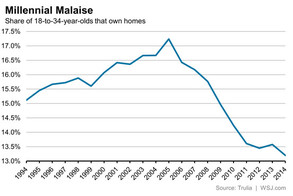
New data show that household formation slowed considerably last year, a potentially ominous sign for the housing market.
Household formation is a key driver of demand for housing. When the economy stumbles and joblessness rises, more people tend to move in with family or double up with roommates. When the economy expands, the opposite takes place as people strike out on their own. Household formation also rises when immigration increases.
Last week, an annual Census Bureau survey showed that the U.S. added just 476,000 households in the year ended in March, compared with an average of 1.3 million in each of the prior two years.
The Census releases a separate quarterly survey that also provides household formation figures, though economists say the annual survey is a better gauge of household formation. The quarterly survey has also shown weak household formation, around 650,000 new household, for the same period measured by the annual survey that runs from March to March.
Household formation is a key driver of demand for housing. When the economy stumbles and joblessness rises, more people tend to move in with family or double up with roommates. When the economy expands, the opposite takes place as people strike out on their own. Household formation also rises when immigration increases.
Last week, an annual Census Bureau survey showed that the U.S. added just 476,000 households in the year ended in March, compared with an average of 1.3 million in each of the prior two years.
The Census releases a separate quarterly survey that also provides household formation figures, though economists say the annual survey is a better gauge of household formation. The quarterly survey has also shown weak household formation, around 650,000 new household, for the same period measured by the annual survey that runs from March to March.
Either way, for the most recent year, both surveys “show disturbingly slow growth,” said Thomas Lawler, an independent housing economist in Leesburg, Va.
The surveys may help shed light on why the housing market hasn’t recovered as steadily as many had expected over the past year. Sales and construction of new homes are barely running ahead of last year’s pace, though the vacancy rate for professionally managed apartments has fallen to a 13-year low, according to real estate data firm Reis Inc.
Additional calculations of the same annual survey from Jed Kolko, chief economist at Trulia, show that the U.S. population grew by 2.3 million last year. If household formation continued at the rate of the past few years, the U.S. would have added 1.2 million households last year. Instead, Mr. Kolko’s calculations show it added just 425,000, and nearly all of them were renter households.
Mr. Kolko found that the share of young adults living with their parents ticked down last year, which is good news. The bad news: They didn’t form their own households, perhaps moving in with other relatives or friends. This helps explain why the homeownership rate for, 18 to 34 year olds, continued to fall last year.
Homeownership rates can fall when household formation increases because the pool of renters grows faster than the pool of owners. But the data released last week suggests that this relatively benign explanation of falling homeownership rates can’t explain the drop in homeownership last year, a troubling sign.
Indeed, the data had pointed to signs that the homeownership rate for millennialshad stabilized last year after accounting for the growth in renter households. But Mr. Kolko said the latest survey shows that the millennial homeownership rate declined against last year. Around 13.2% of, 18 to 34 year olds, owned homes in the year ended March 2014, down from a peak of 17.2% in 2005 and 13.6% in 2013.
Source: Christian Science Monitor
The surveys may help shed light on why the housing market hasn’t recovered as steadily as many had expected over the past year. Sales and construction of new homes are barely running ahead of last year’s pace, though the vacancy rate for professionally managed apartments has fallen to a 13-year low, according to real estate data firm Reis Inc.
Additional calculations of the same annual survey from Jed Kolko, chief economist at Trulia, show that the U.S. population grew by 2.3 million last year. If household formation continued at the rate of the past few years, the U.S. would have added 1.2 million households last year. Instead, Mr. Kolko’s calculations show it added just 425,000, and nearly all of them were renter households.
Mr. Kolko found that the share of young adults living with their parents ticked down last year, which is good news. The bad news: They didn’t form their own households, perhaps moving in with other relatives or friends. This helps explain why the homeownership rate for, 18 to 34 year olds, continued to fall last year.
Homeownership rates can fall when household formation increases because the pool of renters grows faster than the pool of owners. But the data released last week suggests that this relatively benign explanation of falling homeownership rates can’t explain the drop in homeownership last year, a troubling sign.
Indeed, the data had pointed to signs that the homeownership rate for millennialshad stabilized last year after accounting for the growth in renter households. But Mr. Kolko said the latest survey shows that the millennial homeownership rate declined against last year. Around 13.2% of, 18 to 34 year olds, owned homes in the year ended March 2014, down from a peak of 17.2% in 2005 and 13.6% in 2013.
Source: Christian Science Monitor

 RSS Feed
RSS Feed